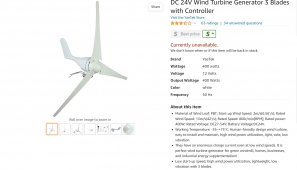ROI $ is not as clear cut as a simple wattage calculation for me. As the majority of my winds are after sundown, lessening cycle depth plays some part on battery life. I don't have any with/without wind assistance longevity data, but I know it helps some.
As heat is the enemy of electronics, taking some load from my charge controllers during the day helps to a smaller degree as well.
Model:
View attachment 117689
For braking, I have an a/c electric water heater programed as a dump load for excess solar and wind. It gradually increases current to the water heater element starting @ 27.5V and ramping up to 100% of 2000 watts at 28V. This, along with standard ac loads, has been effective.
Right now it is producing 28 watts at at 27.5V at 3mph wind speed according to my clamp meter and home weather station.




![20221025_125815[1].jpg 20221025_125815[1].jpg](https://diysolarforum.com/data/attachments/117/117829-b103fc828b225ecfdf057dcd694e639b.jpg)